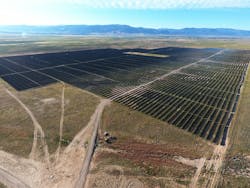Green River Energy Center in Utah to Quadruple Battery Storage Capacity to 1,600 MWh
The privately held renewable energy developer rPlus Energies’ Green River Energy Center project, a solar-plus-storage facility in Utah, has revised its PPA with PacifiCorp to quadruple the battery storage capacity from 400 MWh to 1,600 MWh.
The project, with a capital investment of more than $1 billion and a combined solar and storage capacity of 800 MW, will start construction in Q2 2024. rPlus plans to bring the project to market for tax and debt financing later in 2024.
The Green River Energy Center stands as one of the largest planned solar-plus-storage facilities in Utah and ranks among the most expansive energy facilities within the PacifiCorp System - a grid operator in the western US.
The project is expected to create about 500 construction jobs during its development. Once operational, it will also improve local tax revenue for Emery County and offer long-term energy employment opportunities.
Green River Energy Center has selected Sundt Construction to provide engineering, procurement, and construction services.
Recently, rPlus also secured an investment of up to $460 million from Sandbrook Capital, a private investment firm, to help expand into ownership and operation of its projects.
About the Author
EnergyTech Staff
Rod Walton is senior editor for EnergyTech.com. He has spent 17 years covering the energy industry as a newspaper and trade journalist.
Walton formerly was energy writer and business editor at the Tulsa World. Later, he spent six years covering the electricity power sector for Pennwell and Clarion Events. He joined Endeavor and EnergyTech in November 2021.
He can be reached at [email protected].
EnergyTech is focused on the mission critical and large-scale energy users and their sustainability and resiliency goals. These include the commercial and industrial sectors, as well as the military, universities, data centers and microgrids.
Many large-scale energy users such as Fortune 500 companies, and mission-critical users such as military bases, universities, healthcare facilities, public safety and data centers, shifting their energy priorities to reach net-zero carbon goals within the coming decades. These include plans for renewable energy power purchase agreements, but also on-site resiliency projects such as microgrids, combined heat and power, rooftop solar, energy storage, digitalization and building efficiency upgrades.
